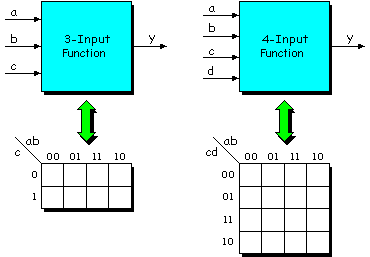|
|
|
|
|
|
|
 |
| These discussions were abstracted from the book, Bebop to the Boolean Boogie (An Unconventional Guide to Electronics), with the kind permission of LLH Technology Publishing, Eagle Rock, VA, USA. Bebop to the Boolean Boogie provides a superb introduction to a smorgasbord of contempory digital electronics, including atoms, transistors, logic gates, Eskimo counting systems, fuzzbuttons, smoked fish, musical socks, Reed-Müller logic, seafood gumbo, integrated circuits, circuit boards, hybrids, multichip modules, optical interconnects, protein memories & switches, holographic interconnects, superconductors, nanotechnology, and much, much more! |
| Karnaugh Maps Part 1: Introduction |
| Karnaugh maps provide an alternative technique for representing Boolean functions. For example, consider the Karnaugh map for a 2-input AND gate (Figure 1). |

Figure 1: Karnaugh map for a 2-input AND gate. |
|
| The Karnaugh map comprises a box for every line in the truth table; the binary values above the boxes are those associated with the a and b inputs. Unlike a truth table, in which the input values typically follow a standard binary sequence (00, 01, 10, 11), the Karnaugh map's input values must be ordered such that the values for adjacent columns vary by only a single bit, for example, 00, 01, 11, and 10. This ordering is known as a gray code, and it is a key factor in the way in which Karnaugh maps work. (Gray codes are discussed in more detail in Appendix D of Bebop to the Boolean Boogie.) | ||
| The
y column in the truth table shows all
the 0 and 1 values associated with the gate's output. Similarly, all of
the output values could be entered into the Karnaugh map. However, for
reasons of clarity, it is common for only a single set of values to be
used, typically the 1s.
Similar maps can be constructed for 3-input and 4-input functions (Figure 2). In the case of a 4-input map, the values associated with the c and d inputs must also be ordered as a gray code; that is, ordered in such a way that the values for adjacent rows vary by only a single bit. |

Figure 2: Karnaugh maps for 3-input and 4-input functions. |
|
|
 |
|
|
|
|
|
|